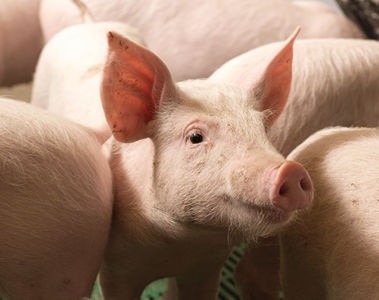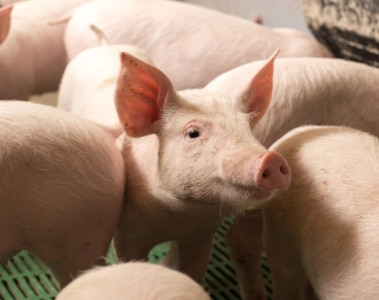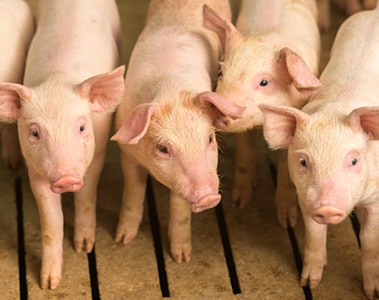
-
North America/EN
- Global
- North America
- Latin America
The significance of feed biosecurity in the swine industry cannot be overstated. Producers must employ measures that mitigate this risk with the potential for feed to act as a vector for viral pathogens. Among the various strategies available, feed additives like VVC Premix have garnered attention for their ability to enhance feed biosecurity while supporting swine performance.
The 2013 Porcine Epidemic Diarrhea Virus (PEDV) outbreak in the United States highlighted the risk of feed serving as a vector for viral diseases in swine. Research has shown that viruses such as PEDV, African Swine Fever Virus (ASFV), and Foot-and-Mouth Disease Virus (FMDV) can survive in feed under specific conditions (S. Dee et al. 2014; Zhai et al. 2021; Gebhardt et al. 2019). Additionally, studies indicate that these viruses can endure in feed ingredients during transcontinental and transoceanic shipping, emphasizing the need for stringent biosecurity measures in feed management (S. A. Dee et al. 2018; S. Dee et al. 2022). This situation highlights the critical importance of incorporating effective active ingredients in feed additives to prevent the spread of these diseases through feed (IPIC 2022; KSU 2022).
Among the most effective active ingredients used in feed additives are essential oils and organic acids. These compounds have been extensively studied for their ability to reduce the infectivity of viruses in feed, making them critical components in enhancing feed biosecurity (Hough and Bergstrom 2024).
Feed additives like VVC Premix are specifically designed to enhance feed biosecurity. These products combine essential oil compounds and organic acids, and their effectiveness has been tested against various viral pathogens, including PRRSV, PEDV, and ASFV (S. Dee et al. 2014; Zhai et al. 2021; Gebhardt et al. 2019). Studies have shown that when these additives are incorporated into swine feed at the recommended inclusion rates, they can significantly reduce the presence of viral RNA in feed samples. This reduction in viral load improves the overall safety of the feed, helping to prevent the transmission of viruses to pigs through contaminated feed (S. A. Dee et al. 2021; IPIC 2022).
Previous research supports the effectiveness of feed additives like VVC Premix. For example, a study highlights the efficacy of a feed additive, VVC, which combines benzoic acid and nature-identical flavorings, in improving nursery pig performance. A recent study conducted with 5,466 nursery pigs demonstrated that VVC significantly decreased total morbidity and mortality rates (from 4.45% to 3.27%) compared to the control group. These findings indicate that VVC could be useful for enhancing nutrition and growth performance, beyond its capabilities for mitigating the potential for pathogen contamination of feed (Hough and Bergstrom 2024).
In a study assessing the effectiveness of various feed additives in mitigating the risk of virus-contaminated feed, the additive VVC was evaluated at inclusion rates of 0.5% and 0.3% per ton of feed. The results demonstrated that the pigs fed with VVC-supplemented feed exhibited significantly improved health outcomes compared to the control group. Specifically, the VVC-treated groups showed no clinical signs of disease, drastically reduced presence of viral RNA in post-mortem samples, and an increased average daily gain (ADG), reaching up to 0.54 kg/d compared to 0.14 kg/d in the control group. Mortality rates were also lower in the VVC groups, underscoring the additive's potential to enhance swine health and performance when feed is contaminated with pathogens in commercial operations (S. A. Dee et al. 2021).
While the primary goal of feed mitigation additives is to enhance biosecurity and support animal health, economic considerations also play a significant role in their adoption. Feed additives like VVC Premix are designed to be cost-effective, with inclusion rates that provide substantial benefits at a relatively low cost. This makes them an attractive option for producers looking to enhance the safety and performance of their swine herds without incurring prohibitive costs (KSU 2022).
Moreover, the ease of application and implementation of dry products (i.e., granulated or powder), like VVC Premix, that do not require additional equipment, further contributes to their cost-effectiveness. Producers can integrate these additives into their existing feed management systems, making them accessible to operations of all sizes.
In conclusion, incorporating selected essential oils and organic acids into well-researched feed additives is a crucial step for enhancing feed biosecurity and supporting the overall health and performance of swine herds. VVC Premix, specifically, serves as a valuable tool in this effort. These ingredients have been scientifically validated for their effectiveness in reducing viral loads in feed, making them valuable components of a comprehensive biosecurity strategy. By offering a reliable and cost-effective solution, VVC Premix helps swine producers protect their herds from the risks of viral contamination in feed. As the swine industry continues to face evolving challenges, integrating products like VVC Premix into biosecurity protocols will be essential for maintaining the health and productivity of swine herds globally.
Not all products are available in all markets nor associated claims allowed in all regions (including but not limited to USA and Canada).
16 September 2024


17 Jan 2022

We detected that you are visitng this page from United States. Therefore we are redirecting you to the localized version.